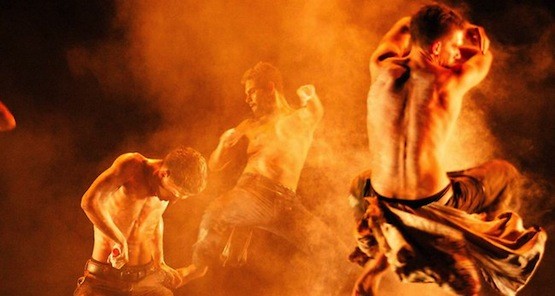
Boys in hoodies fight under street lights, sirens sound, drum and bass reverberates and the stage is lit by the glow of phone booths and television screens. A world away, men and women dance together harmoniously against a backdrop of rock formations, mist, rain, and sand.
The brilliance of Blak, the latest production by indigenous dance company Bangarra, is the way it explores both these worlds, showing them to be intertwined.
In the show’s liner notes, dancer and choreographer Daniel Riley McKinley discusses the divide between a life defined by tradition and one which takes place in a starkly contemporary context:
“Rites of passage and initiation ceremonies are a continued living practice throughout indigenous Australia … these practices strengthen, educate, empower and give rise to the new generations coming through. But what about the boys and men living an urban life?”
Scar, the show’s first act, explores this question. Choreographed by McKinley, it has the male dancers shifting between ritualised combat, and a more chaotic kind of violent movement. It’s an electrifying opening to the show, as familiar at times as a Saturday night pub fight and yet elegant and otherworldly.
To research the show, the troupe spent time in North East Arnhem Land learning from local communities. The next act, Yearning, explores some of the women’s stories. Luke Ede’s costume design suggests the contrast between different categories of female experience; from vulnerable, doll-like nighties, to flowing deep blue dresses and Boudiccea-like silver skirts; part armor, part ornament. Women appear in many guises throughout, but the most striking scene is also the most disturbing; Broken features female dancers lit only by a beam of light emitted from a video camera. Their images appear alongside them in real time, projected voyeuristically onto a television screen through which they appear as tiny, objectified bodies without agency.
By contrast the final act, Keepers, presents a more unified vision, with male and female performers coming together in increasingly reciprocal movements. Referencing the role of dancers as cultural caretakers, Bangarra artistic director Stephen Page describes it as a homage to traditional knowledge. Imbued with a sense of balance and togetherness, its quietly moving conclusion is aided by fantastical set design including rain and sand, smoke which is also mist and a huge rock-like metallic backdrop.
Jacob Nash’s sets impress throughout, frequently placing man-made structures in the foreground — milk crates, a phone box — whilst huge, more organic forms hover in the background. There is the sense that the dancers’ journeys are taking place against a larger backdrop which transcends their urban surrounds. Matt Cox’s light design is at its most atmospheric when nocturnal; in Scar, the men dance under a street-light like glow, in Yearning the women are bathed in neon. By comparison, the more gentle and naturalistic light of the final act is calming, but lacks the same visual punch.
David Page and Paul Mac’s music — amazingly Mac’s first foray into composing for contemporary dance — is stunning at every turn, artfully blending folk song with electronic sounds.
The details: Blak is at The Arts Centre’s Playhouse until May 11 — tickets on the venue website. The show travels to Wollongong (May 17-18), Sydney (June 7-22), Canberra (July 11-13) and Brisbane (July 18-27) — more information on the company website.







Crikey is committed to hosting lively discussions. Help us keep the conversation useful, interesting and welcoming. We aim to publish comments quickly in the interest of promoting robust conversation, but we’re a small team and we deploy filters to protect against legal risk. Occasionally your comment may be held up while we review, but we’re working as fast as we can to keep the conversation rolling.
The Crikey comment section is members-only content. Please subscribe to leave a comment.
The Crikey comment section is members-only content. Please login to leave a comment.